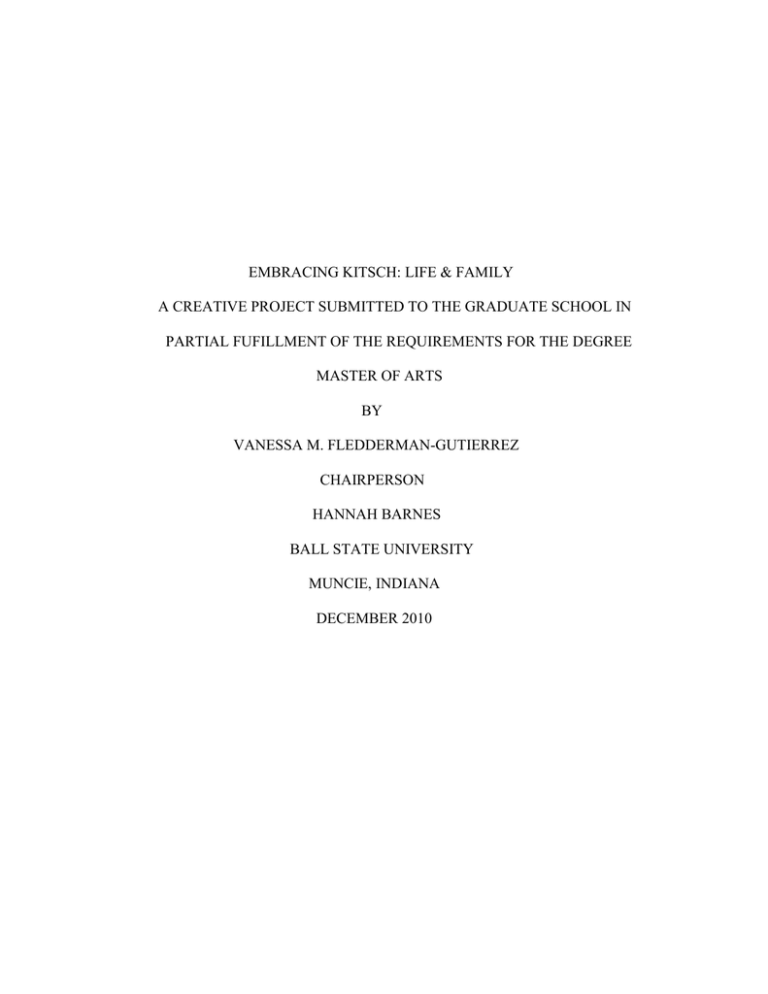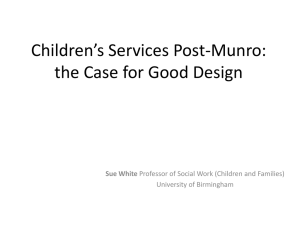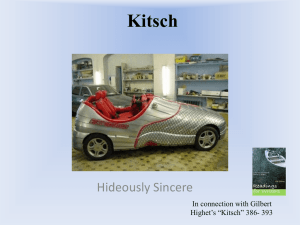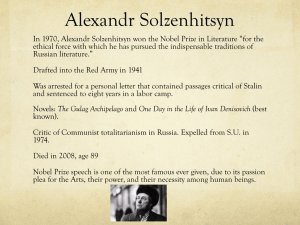EMBRACING KITSCH: LIFE & FAMILY
advertisement

EMBRACING KITSCH: LIFE & FAMILY A CREATIVE PROJECT SUBMITTED TO THE GRADUATE SCHOOL IN PARTIAL FUFILLMENT OF THE REQUIREMENTS FOR THE DEGREE MASTER OF ARTS BY VANESSA M. FLEDDERMAN-GUTIERREZ CHAIRPERSON HANNAH BARNES BALL STATE UNIVERSITY MUNCIE, INDIANA DECEMBER 2010 Embracing Kitsch: Life and Family Kitsch and Inspiration “Children and old people are the source of the worst type of sentimentality, which inevitably produces the purest form of kitsch” (Dorfles 130). As I read this statement, I fell in love with an idea…the sentimentality, tastelessness, and negativity usually associated with kitsch. However, rather than run from the tastelessness of the subject, I decided to embrace it, to embrace the kitsch in my life and work. For this creative project I have chosen to focus on the imagery of my past and present to create a series of drawings and mixed media pieces that explore my personal relationship with kitsch images. Throughout my life, I have always been a keeper of my childhood things and a collector of things that remind me of it. In a sense, I am a collector of memories built around objects and images. As I age, my collection of things and memories linked to my past continues to grow, especially now that I have a child. Becoming a mother is a strange thing. To think that I am not only creating my experiences but now those of my daughter raises all types of feelings and emotions. One major emotion is the sentimentality I have for what was and soon will be the past- my past, her past, our past. It is hard to escape the sentimental when raising a child. As a mother, it is hard to escape the sentimental side of kitsch. In my current collection of artwork, it has been my intent to explore the personal relationship I have with my kitsch lifestyle and the images/objects that fill it. Fledderman-Gutierrez 2 I felt the need to create a body of work that in some way relates to my personal affection for the past as well as for the new relationship I have with my daughter. For this specific body of work, I have focused on the things that I have experienced as a child that directly relate to the current childhood of my daughter. I have chosen images that we both have a kitschy love for…specifically the woodland creatures from Disney‟s Snow White. In researching kitsch, I found that it is easy to find but hard to define. The TATE Britain website defines kitsch as “the German word for trash… in the 1920‟s it came into use to describe cheap, vulgar, and sentimental forms of popular and commercial culture” (Tate Glossary). Other definitions label it as an art of „bad taste‟ that focuses on the sentimental and lacks originality. A Google image search for kitsch pulls up all kinds of strange and wonderful pop culture imagery and objects of decoration, but to do a search of the term leads to a serious debate on the purpose and significance of kitsch. Many of the writings, especially those of the past, have definite negative attitudes toward kitsch. In Clement Greenberg‟s argument “The Avant-Garde and Kitsch”, Greenberg states, “Kitsch is the product of the industrial revolution which urbanized the masses… Kitsch is deceptive… Kitsch keeps a dictator in closer contact with the „soul‟ of the people” (Greenberg 9-19). According to Greenberg, kitsch is a political tool used to manipulate the peasant or the everyman. It can be understood by all and in turn be used as propaganda to sell the policies of the governing body. In contrast to this, the first image that shows up on the Wikipedia definition page for kitsch is a garden gnome. What an interesting juxtaposition of ideas. On the one hand, there is Greenberg, on the other, garden gnomes. In this sense, it is hard to determine true kitsch. Is it found in the Fledderman-Gutierrez 3 innocence of garden gnomes, or is it a political tool used to manipulate the masses? As I continued my work, I struggled with these opposing views. I often found myself wondering if I should explore kitsch at all. Negative attitudes abound. The kitsch-man, a term coined by writer and kitsch critic Hermann Broch, is insulted for his apparent lack of intelligence and his inability to appreciate the higher thoughts of high culture-modern art (Dorfles 15). However, as I read on I felt a connection to the kitsch-man, the common man, the peasant; in a way, I am this man. I am kitsch. With this acceptance of my peasant lot in life, the goal of my work was to embrace this part of my life. In part, kitsch has a bad name because it can be mass-produced and enjoyed by all. Because all can enjoy and appreciate it, many critics believe there is nothing special or unique to kitsch objects. However, I believe there is uniqueness to these objects that lies in the relationship the owner of the object has with that object. Kitsch can be personal. Objects can make one recall specific memories. The idea of this personal relationship with a mass-produced object/image interests me greatly. It is the reason I have collected things that remind me of my past. I have always enjoyed and collected cartoon images and children‟s book illustrations. The personal relationship I have with specific mass-produced images has been the catalyst for the artworks in my current collection. In The Artificial Kingdom: On the Kitsch Experience, Celeste Olalquiaga writes of the uniqueness of a mass-produced item and one‟s relationship with it: “uniqueness is not intrinsic to an object, but rather takes place in the historical interaction between subject and experience…Uniqueness happens when objects are personalized in the Fledderman-Gutierrez 4 privacy of someone‟s specific universe…” (17). In Olalquiaga‟s writing, I found my thoughts expressed in words. The personal relationship one has with a mass-produced object/image is one of the main threads running through my current body of work. I have taken the mass-produced cartoon images of Walt Disney that millions of others have enjoyed and placed them in a personal context. These images have become a part of my life and my history, despite the fact that others may have their own history with the same image. These images have become mine, and it was my intent in my current work to illustrate my relationship with them. With the exception of Olalquiaga‟s writings, the idea of the personal relationship one has with a kitsch object often goes unexplored. Writers and artists seem to focus more on the mass-production side of kitsch, as opposed to the emotions tied to it. When researching kitsch, it is impossible to ignore two contemporary artists exploring the subject: Odd Nerdrum and Jeff Koons. Although both of these artists have tackled kitsch in their art, their work and theories could not be more oppositional. Jeff Koons is an artist of pop culture. One look at his work and the viewer gets a glimpse of his pop art sensibility. Koons has created works that range from a large puppy sculpture made of flowers, entitled Puppy, to smaller works that reference toys and objects of 1980‟s consumerism. In The Jeff Koons Handbook by Koons, he addresses the idea of art and class: I‟ve tried to make work that any viewer, no matter where they came from…would have to say that on some level „Yes, I like it.‟ If they couldn‟t do that, it would only be because they had been told they were Fledderman-Gutierrez 5 not supposed to like it. Eventually they will be able to strip all that down and say „You know, it‟s silly, but I like that piece. It‟s great. (112) At first glance, many of Koons‟ pieces look as if they are meant to be enjoyed by all, by kitsch-men and women; however, upon further study of Koons, one realizes that Koons is an artist of contradictions. Although Koons has stated that he wants his work to be enjoyed by all, many of his actions and words counteract this idea. Much of Koons‟ work is outrageously kitsch in a way that does not seem to celebrate kitsch, but merely makes a mockery of it for those paying attention. One piece in particular, entitled Large Vase of Flowers done in 1991, at first looks like any average kitschy vase of plastic flowers that you might find in any grandmother‟s home. However, describing this piece, Koons states “In the Large Vase of Flowers there are 140 flowers. They are very sexual and fertile, and at the same time they are 140 assholes” (126). This is the type of statement that I believe, in some way, aligns Koons with Greenberg. Koons on the one hand is making these fun pop art pieces, that are alluring on the outside, but in reality have the deceit of, for lack of a better word, a smart ass artist trying to separate his work into a higher category of art where only a few get the joke. Because of this attempt to pull in and then ostracize the masses, Koons‟ work loses its appeal. Koons is attempting to elevate his art above that of mere kitsch. There is no heart in the work of Koons, but merely another snide comment that attempts to elevate his work and status above others. On the other side of the contemporary kitsch debate is artist Odd Nerdrum. Nerdrum has written extensively on the subject of kitsch and art, and it has been said that Fledderman-Gutierrez 6 he is a kitsch painter as opposed to an artist. In On Kitsch, Sindre Mekjan writes on Nerdrum‟s ideas concerning kitsch and art: Art, [Nerdrum] believes is something which both enlightens people and which is used by society. Kitsch, on the other hand, involves the private individual, not politically, but passionately and sensually… modernists feared that kitsch would be used as an ideological tool… Nerdrum believes the contrary; that it is art which has become a part of the official state ideology or structure. (18) This statement goes against the ideas of Greenberg, who believed that kitsch, not modernism, was used as a tool to manipulate the masses. When looking at Nedrum‟s work, there is no denying the contemplative and seriousness of his subject matter, especially in contrast to that of Jeff Koons. Nerdrum makes no apologies for his work and the kitschiness of it. Nerdrum states: Kitsch is about the eternal human questions, the pathetic… The task of kitsch is to create a seriousness in life, at its best so sublime it will bring the laughter to a quiet. Kitsch serves life and therefore seeks the individual…God knows I have strived to become skillful enough to depict man‟s longings in my kitsch. And what could possibly drive us more strongly than the longings of childhood and youth?” (11-12) Nedrum‟s statement brings me back to the statement of Dorfles that children and old people produce the “purest form of kitsch”. Although Dorfles was an opponent of kitsch and Nerdrum an advocate, the two illustrate that kitsch is personal, and most times, sentimental. Fledderman-Gutierrez 7 Nerdrum and Koons are so different that it is difficult to say that my current body of work has been influenced by both, but I believe that my work lies somewhere between the work of Koons and Nerdrum. The images I have chosen for my current pieces relate more to a Koons version of kitsch, but my thoughts on them and the way they relate to my personal experience do not relate to Koons at all. I am not a Jeff Koons sort of artist; it is not my intent to poke fun at viewers who truly love and enjoy kitsch objects. Despite this, I do love the pop imagery Koons relies upon. The content of my work, on the other hand, falls more in line with that of Nerdrum. I enjoy and employ sentimental images, but the sentimental images I rely on happen to be mass-produced cartoon images that millions have had a relationship with. I enjoy pop images; however, when subject matter is concerned, I enjoy sentimentality and honesty. Nerdrum confronts sentimentality in his work by confronting human emotions through human form in his paintings. Although I enjoy this about Nerdrum‟s work, it was not the intent of my work. In the pieces created for my creative project, I attempted to take a kitsch/pop image and make it personal. In doing so, it is my hope that the works will trigger memories in my viewers of their own relationship with kitsch objects/images. The Work and Exhibition Pieces The works I have made for my creative project are focused on the images and objects that occupy much of my everyday life. As a mother, I am constantly bombarded with cartoon imagery and toys. As stated earlier, for this body of work I have focused on images of early Disney cartoons, specifically the woodland creatures from the story Snow Fledderman-Gutierrez 8 White. There is something lovably sweet, innocent, and kitsch about Snow White and her animal companions. I have a nostalgic connection to them that stems not only from my own childhood but the childhood of my daughter as well. I have always loved old illustrations and the graphic quality of cartoons and the toys that accompany them. This body of work has provided a way for me to express that affection. Most works in this series have been done on a traditional paper surface; however, I have shaped each paper work by trimming the sides and adding paper doilies to create a drawing that becomes more of an object, a kitsch object, for the viewer to enjoy. I have created a few pieces on wooden planks and sticks of driftwood. I used these nontraditional wooden surfaces to illustrate my love and memories of the overly shellacked souvenirs found in most tourist souvenir shops, another wonderfully kitschy memory of childhood. I enjoy the juxtaposition of a natural surface with a graphic image. I have always enjoyed merging two opposing ideas/images in my work. I think the specific marriage of the natural wood with the plastic cartoon image reminds me of my childhood growing up on 120 wooded acres where I spent my weekends watching Saturday morning cartoons and exploring the wilderness that surrounded me. Establishing a personal vocabulary of symbols has played an important role in the creation of these pieces. When choosing images, I found that there is something lovable about Snow White‟s animal companions. I decided to use these creatures as a visual representation of my daughter and my experiences parenting her. I have used these creatures to confront the emotions, events, and responsibilities I am facing as a parent. One event I have focused on is the unstoppable growth of my child, and my responsibility to lead her in the safest direction. Many of the works in this series contain a Fledderman-Gutierrez 9 line either around an animal‟s neck or lying near it. This line at first was meant to illustrate the responsibility involved in protecting and disciplining a child. It was a symbol to stop growth, a tether to keep one safe, a leash to contain the wild; however, as the pieces progressed I realized that the line can represent many different things to different people. It can be a means of holding one back, a chain that confines. In some works the line has fallen from the creature‟s neck, setting it free, yet the creature stays. This line has become a loaded image, capable of many interpretations. Because of this openness of interpretation, I hope that my viewers not only see my story in that line, but can insert their story as well. Other, perhaps less symbolic, images in the work involve paper doilies and a reference to souvenirs. The doilies attached to many of the pieces are simple dollar store finds. I have used the doilies to build a skirt or ruffle on the edge of the paper works. The doilies are a reference to my daughter‟s Mexican heritage and the wonderful dresses worn by Mexican folklorico dancers. The doilies also provide a means to allude to the delicateness of childhood and the overly sentimental feelings I have experienced in motherhood. I have also created a few works on wooden surfaces to pay homage to the overly shellacked wooden souvenirs found on family vacations to state and amusement parks. I have always been drawn to the aesthetic of souvenirs, and this body of work allowed me to experiment with this aesthetic. All of the pieces in this series rely on minimal use of color and line. I have chosen to portray all of the images and symbols in a fragmented, almost ghostlike, way. I have used white oil pastels or paint to create a thin layer of color over a graphite image. This manner of approach alludes to the creation of memories. Memories are many times Fledderman-Gutierrez 10 fragmented and become layered after many bygone years, and most of the time, details are forgotten. My handling of materials and erasing of the details in the final image is a reference to this occurrence. I also believe that the use of fragmented imagery and minimal materials allows my viewer the opportunity to insert their own story, or memory, into my work. All of the works on paper have been created in groups of three. The magic number when a couple becomes a family. The exhibition component of this creative project, entitled Embracing Kitsch: Life and Family, includes three large works entitled Large Deer, Large Squirrel, and Large Rabbit, as well as a trio of small works entitled Small Deer, Small Squirrel, and Small Rabbit. There is also a grouping, or family, of three works entitled Rabbit Series. There are two wood groupings in the show: Oval Set #1 and Deer Stick and Circle. The titles are left generic in order to leave room for interpretation. The story of each piece is ultimately left for the viewer to tell. My memory or experience merely becomes a catalyst for the viewer‟s thoughts and recollections. Conclusion This body of artwork and research has resulted in my creative project exhibition, Embracing Kitsch: Life and Family. I have found that by creating this body of work, I have made the most honest work I have ever made. I have never tackled subject matter this personal in prior work, and, at times, it has been difficult to make this transition. Having my daughter changed my life, and subsequently has changed my work. The purpose of this work and research was to explore the issues I am now facing as a parent, Fledderman-Gutierrez 11 to celebrate the kitschiness of my life, and to create a body of work that others can enjoy and relate to. Having my daughter has made me realize how important childhood experiences are. The memories, the images, and the objects that fill her childhood will remain with her throughout her life- just as my childhood has remained with me- just as my viewer‟s childhood has remained with him/her. Although no person‟s childhood is perfect, many of us have fond memories of the past. Rather than focus on the negative things that can happen as one grows, I decided to focus on some of my fondest childhood memories that correspond with the childhood of my daughter. It does seem strange that some of my favorite memories revolve around cartoons and toys, but I think many people can recall a memory that involves their favorite plaything or show, and how that item/image made them feel. In my own life, I watch my daughter love her things, as I loved mine. Although my work focuses on things other than the wonders of childhood, I found it necessary to explore this love. By exploring this love, I realized the importance of the relationship a person can have with a mass-produced, kitsch object/image. I wanted to illustrate this relationship and the importance of these objects in people‟s lives. Celeste Olalquiaga writes on her relationship with her beloved kitsch object, Rodney, a hermit crab encased in a glass globe, and the power that Rodney has had over others: “… people look into the glass globe without really seeing it, but rather unwittingly gazing beyond it into their own unconscious-- the fears and desires that wait silently until the least-expected stimulus triggers their remembrance” (78). Fledderman-Gutierrez 12 Like Rodney, my pieces are meant to inspire a remembrance within the viewer. I think I achieved this in Embracing Kitsch. The images are relatable to almost any viewer. Almost everyone has seen the Disney illustrations I have used. I am dealing with massproduced, kitsch imagery that everyone has a relationship with; however, I have taken those images and turned them into artworks that directly relate to my life and my relationship with them. This creative project has provided me the opportunity to explore and examine my role as a mother and my love of things and images. I have enjoyed creating pieces so loveable and strange at the same time… very much like the experiences I am having as a mom. The work I have created is very personal and has provided an outlet for my expression. This series of work has given me the opportunity to tell my story, and now the work is left to viewer interpretation. As I have said, I have never before made work this personal. I have enjoyed the process, and I feel I have created a body of work that not only confronts the kitschiness of my life and the things that fill it but celebrates it as well. With my new role as mother, I am sure that I will continue to be confronted with issues that I would not have thought about otherwise. Some may say that I should be more than a mother in my work, and I believe I am; however, to deny this role would be to deny a huge part of my life. All in all, I think it would be impossible and unjust to ignore the kitsch in my life and work; so rather than run from it, I will embrace the kitsch in my life and continue to use it to move forward. Fledderman-Gutierrez 13 Works Cited Dorfles, Gillo, et al. Kitsch: The World of Bad Taste. New York: Universe Books, 1970. Greenberg, Clement. “Avant-Garde and Kitsch.” In Art and Culture: Critical Essays. Boston: Beacon press, 1961. “Kitsch”. Wikipedia: The Free Encyclopedia. August 8, 2010. <http://en.wikipedia.org/wiki/Kitsch. Koons, Jeff. The Jeff Koons Handbook. New York: Rizzoli International Publications, 1992. Nerdrum, Odd, et al. On Kitsch. Oslo: Kagge Forlag AS, 2001. Olalquiaga, Celeste. The Artificial Kingdom: On the Kitsch Experience. New York: Pantheon Books, 1998. Snow White and the Seven Dwarfs. Dir. William Cottrell and David Hand. Walt Disney Studios, 1937. Tate Glossary: Kitsch. Tate Collection. August 10, 2010. <http://www.tate.org.uk/collections/glossary/definiton Fledderman-Gutierrez 14 Bibliography Stavans, Ilan. The Riddle of Cantiflas: Essays on Hispanic Popular Culture. Albuquerque: University of New Mexico Press, 1998. Solomon, Robert C., “On Kitsch and Sentimentality.” The Journal of Aesthetics and Art Criticism 49 (1991): 1-14. The Wonderful World of Walt Disney. 4 vols. New York: Golden Press Inc., 1965. Waldman, Diane. Joseph Cornell: Master of Dreams. New York: Abrams, 2002. Fledderman-Gutierrez 15 Appendix Referenced Images Folklorico dancer lizgallelo.com Snow White and the Seven Dwarfs Walt Disney Studios, 1937 Snow White and the Seven Dwarfs Walt Disney Studios, 1937 Fledderman-Gutierrez 16 Yellowstone National Park souvenir Wood Box, maker unknown Puppy Jeff Koons, 1992 Large Vase of Flowers Jeff Koons, 1991 Fledderman-Gutierrez 17 Hope Odd Nerdrum Oil on canvas, 2001 Dawn Odd Nerdrum Oil on canvas, 1990 Fledderman-Gutierrez 18 Exhibition Images Rabbit Series, oil pastel and graphite, 8”x8” Rabbit Series, oil pastel and graphite, 9”x9” Rabbit Series, oil pastel and graphite, 8”X”8 Fledderman-Gutierrez 19 Small Deer, mixed media, 11”X8” Small Squirrel, mixed media, 9”X9” Small Rabbit, mixed media, 9”x9” Fledderman-Gutierrez 20 Large Rabbit, mixed media, 18”X32” Large Deer, mixed media, 33”X24” Large Rabbit, detail Large Deer, detail Fledderman-Gutierrez 21 Oval Set #1, mixed media collage and drawing, 9”X11” Oval Set #1, oil on wood plaque, 9”X11” Fledderman-Gutierrez 22 Deer Stick and Circle, mixed media, 12”X 28” Deer Stick and Circle, detail





